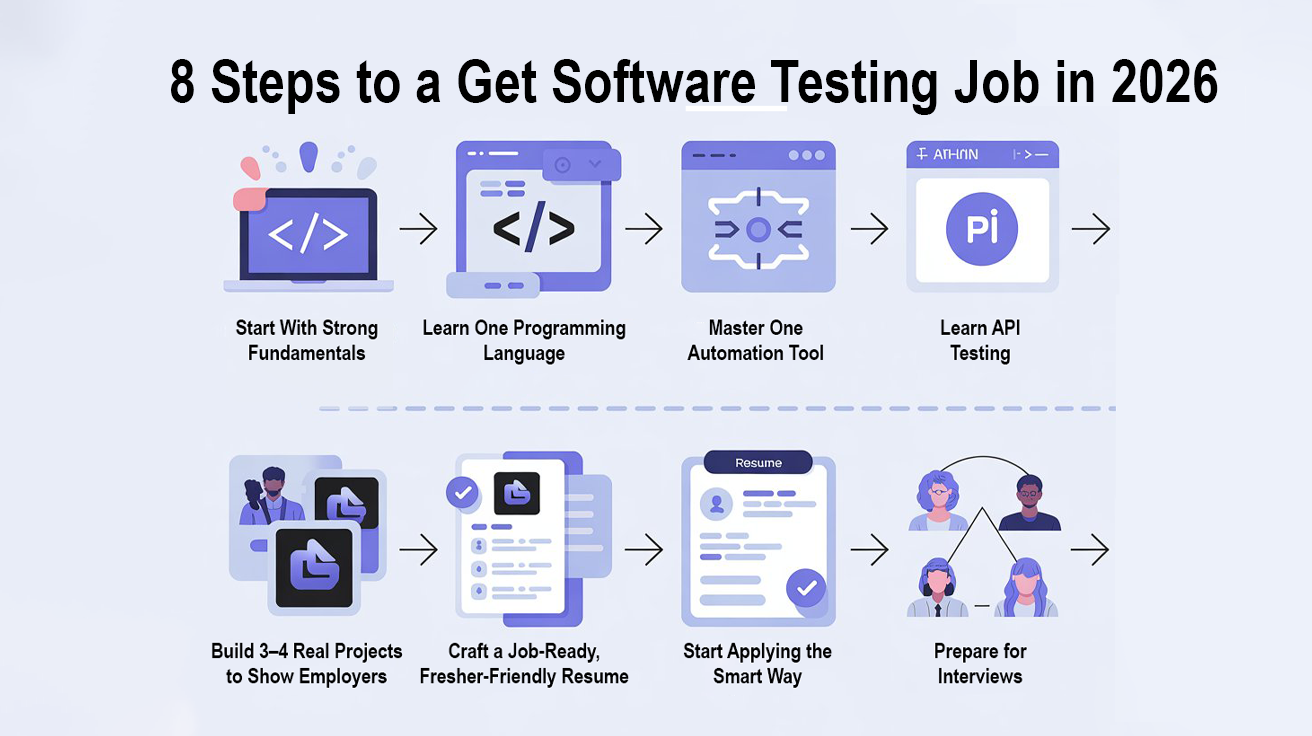Getting a software testing job in 2026 is easier than most people think — if you follow the right steps. But the old approach of learning only manual testing and applying everywhere no longer works. Companies now expect testers to understand business logic, think like users, work with automation tools, and use AI to speed up their workflow.
This guide gives you clear, simple, practical steps to get your first software testing job in 2026 — even if you’re from a non-IT background, a fresher, or someone restarting your career.
Why Software Testing Is One of the Best Careers in 2026
The software industry has changed. Every company wants products that are fast, secure, and bug-free. Without testers, even the best applications fail in the market.
In 2026, testers are expected to work on:
- Web apps, mobile apps, APIs
- Automation tools
- AI-assisted testing
- Agile teams with developers and business analysts
This means more job openings, better salaries, and clear career growth from Manual Tester → Automation Engineer → SDET → QA Lead.
Recommended for You: selenium interview questions
Step 1: Start With Strong Fundamentals (2–4 Weeks)
Before touching any tool, learn the basics of how software works.
You should understand:
- SDLC & STLC – how teams build, test, and release software
- Types of testing – functional, regression, smoke, mobile, API, UI
- Test design – test scenarios, test cases, test data
- Bug reporting – severity, priority, and defect lifecycle
You can learn all of this through free YouTube tutorials or structured platforms. If you prefer guided learning, join a software testing course online for a planned, step-by-step approach.
Step 2: Learn One Programming Language (4–6 Weeks)
In 2026, companies rarely hire testers who know only manual testing. You don’t need deep coding skills, but you must understand the basics.
Pick one language:
- Java
- Python
- JavaScript
Learn only what testers need:
variables, loops, conditions, functions, arrays, strings.
This alone makes you ready for automation tools and interview coding rounds.
Step 3: Master One Automation Tool (6–10 Weeks)
Now comes the most important step: learning automation.
Choose one tool and go deep:
- Selenium (most used in companies)
- Playwright (fast-growing and modern)
Focus on:
- Locators (id, name, CSS, testIds)
- Handling waits, alerts, pop-ups
- Writing scripts for login, search, checkout
- Understanding frameworks like Page Object Model
- Test runners (JUnit, TestNG, pytest, Jest)
You don’t need to learn 10 tools. One tool + strong basics = job-ready.
Related Posts: playwright interview questions
Step 4: Learn API Testing (1–2 Weeks)
95% of companies expect testers to know API basics.
Learn the essentials using Postman:
- GET, POST, PUT, DELETE
- Passing headers, params, and body
- Validating response status and data
- Writing simple tests in Postman
API testing makes your resume stronger than other freshers.

Step 5: Build 3–4 Real Projects to Show Employers
Projects matter far more than certificates.
Create:
1. Manual Testing Project
Pick an e-commerce or banking demo website and create:
- Test scenarios
- Test cases
- Bug reports
- Test summary
2. Automation Testing Project
Automate 5–10 flows:
- Login
- Add to cart
- Search
- Payment simulation
Push all the code to GitHub.
3. API Testing Project
Use Postman on a public API:
- Weather API
- Book API
- Movie API
4. Optional AI Testing Project
Use any AI tool to:
- Generate test cases
- Create test data
- Analyze failed tests
Add everything to a portfolio link you can share with recruiters.
Other Helpful Articles: api automation interview questions
Step 6: Craft a Job-Ready, Fresher-Friendly Resume
Your resume should clearly show that you are job-ready.
Include:
- Skills: manual testing, automation tool, API testing, SDLC, STLC
- Tools: Selenium/Playwright, Postman, Git, JIRA
- Languages: Java/Python/JavaScript
- Projects: list all three projects with results
- Education + certifications
Keep it simple, clean, and focused on testing.
Step 7: Start Applying the Smart Way
Don’t apply randomly. Use this focused method:
1. Job Portals
Apply using keywords like:
- Software Test Engineer
- QA Engineer
- Automation Tester
- Manual + Automation Tester
2. Referrals
Message employees politely on LinkedIn:
- Introduce yourself
- Share GitHub + project links
- Ask for referral
3. Internships
Even 3–6-month internships add huge value to freshers.
4. Consistency
Apply to 20–30 job openings per week, not 2–3.
Step 8: Prepare for Interviews (1–2 Weeks)
Expect these topics:
Manual Testing:
- STLC, bug lifecycle
- Test case vs test scenario
- Severity vs priority
- How you tested your projects
Automation Testing:
- Locators
- Waits
- Assertions
- Simple coding logic
- Your automation project
API Testing:
- Status codes
- JSON validation
- Basic Postman tests
Practice explaining your project clearly — this impresses interviewers more than anything else.
Final Thoughts
If you follow these steps, you can confidently get a software testing job in 2026, even as a fresher or someone from a non-IT background. The demand for skilled testers is only increasing, and companies want people who can think, test, automate, and adapt.
To learn everything in a guided, structured path, you can join a software testing course in Chennai where you get hands-on practice, real projects, and interview support.
You’re closer to your testing career than you think — just start with Step 1 today.
FAQs
1. Can a fresher get a software testing job in 2026?
Yes. With strong fundamentals, basic coding skills, one automation tool, and 2–3 projects, freshers can easily land QA roles in 2026.
2. What skills are required for a testing job in 2026?
SDLC/STLC, manual testing, API basics, one programming language, one automation tool like Selenium or Playwright, Git, and basic DevOps concepts.
3. Do I need coding to become a software tester?
Yes—basic coding (loops, conditions, functions) is essential, especially for automation and SDET roles.
4. Which automation tool should beginners learn?
Start with Selenium or Playwright. Learning one tool deeply is enough to get your first job.
5. How do I build projects as a fresher?
Create manual, automation, and API testing projects. Document test cases, automate 5–10 flows, and upload everything to GitHub.
6. Is a software testing course helpful in 2026?
Yes, a structured software testing course online or an offline course helps you learn tools faster, build projects, and get interview support.
We Also Provide Training In:
- Advanced Selenium Training
- Playwright Training
- Gen AI Training
- AWS Training
- REST API Training
- Full Stack Training
- Appium Training
- DevOps Training
- JMeter Performance Training
Author’s Bio:

Content Writer at Testleaf, specializing in SEO-driven content for test automation, software development, and cybersecurity. I turn complex technical topics into clear, engaging stories that educate, inspire, and drive digital transformation.
Ezhirkadhir Raja
Content Writer – Testleaf









